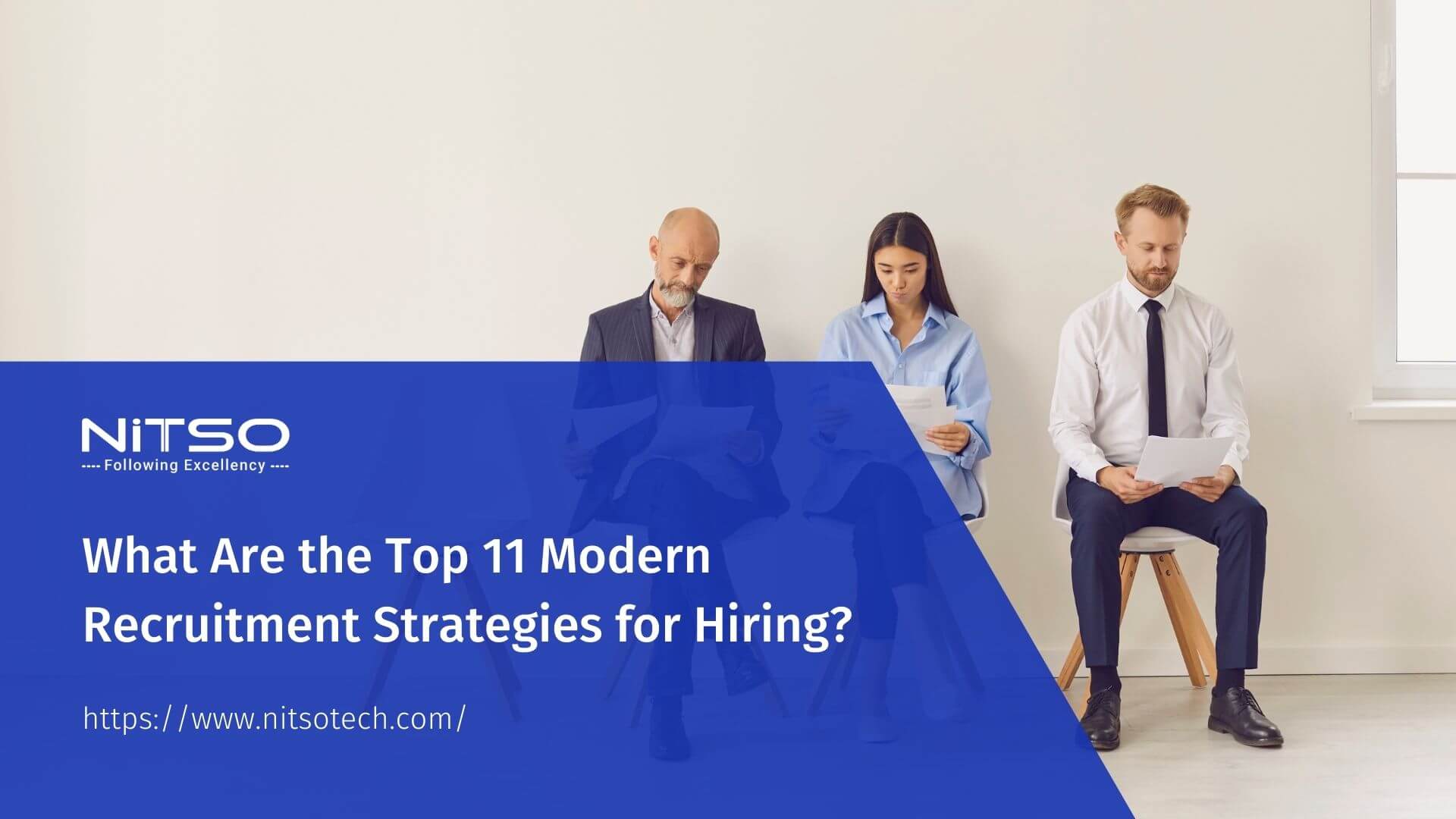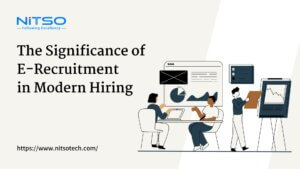In today’s highly competitive job market, how can your company stand out and attract top talent? The answer lies in embracing modern recruitment strategies that go beyond traditional methods. As the workforce evolves and job seekers become more discerning, companies must adapt their approach to recruiting to stay ahead of the curve.
Effective recruitment strategies are crucial for building a strong and talented workforce that drives business success. Traditional methods such as job postings and career fairs may no longer be sufficient to capture the attention of highly sought-after candidates. In fact, according to a study by the Society for Human Resource Management (SHRM), 68% of organizations reported facing recruitment challenges in 2022.
To overcome these challenges and secure the best talent, modern companies must leverage cutting-edge technologies, data-driven insights, and innovative approaches. From leveraging social media and artificial intelligence to prioritizing diversity and inclusion, this comprehensive guide will explore 11 Modern Recruitment Strategies That Will Transform Your Company.
Whether you’re a seasoned HR professional or an entrepreneur looking to build a high-performing team, these strategies will equip you with the tools and knowledge needed to attract, engage, and retain top talent in today’s dynamic job market.
Content On This Page
11 Modern Recruitment Strategies to Revamp Hiring
1: Employer Branding
In today’s competitive job market, employer branding has emerged as a crucial strategy for attracting and retaining top talent. It refers to the perception and reputation of a company as an employer, shaping how potential candidates view the organization and its work culture.
Building a strong employer brand is essential for several reasons. Firstly, it differentiates your company from competitors, making it more appealing to job seekers. In a world where talented individuals have numerous options, a compelling employer brand can be the deciding factor in their job choices. Secondly, a positive employer brand attracts candidates who align with your company’s values and culture, increasing the likelihood of a successful hire and long-term employee engagement.
To develop an effective employer branding strategy, you need to focus on the following key areas:
- Company Culture: Your company’s culture is at the heart of your employer brand. It encompasses the values, beliefs, and behaviours that define your organization. Clearly communicate your company’s mission, vision, and core values through various channels, such as your website, social media, and employee testimonials.
- Employee Value Proposition (EVP): Your EVP is the unique set of benefits and rewards that your company offers to employees. This includes tangible factors like compensation, benefits, and growth opportunities, as well as intangible aspects like work-life balance, company ethics, and workplace environment. Craft a compelling EVP that resonates with your target candidates and communicates what makes your company an attractive place to work.
- Social Media Presence: Social media platforms are powerful tools for showcasing your employer brand. Use platforms like LinkedIn, Facebook, and Twitter to share company updates, employee stories, and behind-the-scenes glimpses of your organization. Encourage employees to share their experiences and engage with potential candidates, fostering a sense of transparency and authenticity.
- Employee Advocacy: Your current employees are the best ambassadors for your employer brand. Encourage them to share their positive experiences through testimonials, referrals, and participation in company events or social media activities. Positive word-of-mouth from trusted sources can significantly enhance your employer brand’s credibility.
- Content Marketing: Develop a content strategy that showcases your company’s expertise, values, and culture. Share thought leadership articles, blog posts, videos, and other content that provides insights into your industry and highlights your organization’s achievements and initiatives. This positioning establishes your company as a desirable employer in the eyes of potential candidates.
By implementing a comprehensive employer branding strategy, you can attract talent that aligns with your company’s values and culture, fostering a more engaged and productive workforce. A strong employer brand not only enhances your ability to attract top talent but also contributes to employee retention and overall organizational success.
2: Employee Referral Programs
One of the most effective modern recruitment strategies is implementing an employee referral program. These programs leverage the existing workforce to identify and recommend potential candidates from their personal and professional networks.
The benefits of an employee referral program are numerous:
- Quality Hires: Employees tend to recommend individuals they know and trust, increasing the likelihood of hiring high-quality candidates who fit the company culture and job requirements.
- Cost Savings: Referral programs can significantly reduce recruitment costs by eliminating the need for expensive job advertisements or external recruitment agencies.
- Faster Hiring Process: Referrals often have a better understanding of the company and the role, leading to a more efficient and streamlined hiring process.
- Employee Engagement: Encouraging employees to participate in the recruitment process can enhance their sense of ownership and commitment to the company’s success.
To create an effective employee referral program, consider the following strategies:
- Incentives: Offer attractive incentives, such as cash bonuses, gift cards, or additional paid time off, to motivate employees to refer suitable candidates.
- Communication: Clearly communicate the program details, including eligibility criteria, the referral process, and rewards, to all employees.
- Tracking System: Implement a system to track and manage referrals, ensuring proper attribution and rewarding of successful referrals.
- Continuous Promotion: Regularly promote the referral program through various channels, such as company newsletters, meetings, and internal social media platforms.
- Feedback Loop: Encourage employees to provide feedback on the referral program, allowing for continuous improvement and addressing any potential issues or concerns.
By implementing a well-designed employee referral program, you can tap into the valuable networks of your existing employees, leading to a more efficient and cost-effective recruitment process while enhancing employee engagement and loyalty.
3: Social Media Recruiting
In the digital age, social media recruiting has become an indispensable strategy for modern organizations. With billions of active users on platforms like LinkedIn, Twitter, Facebook, and Instagram, social media offers a vast pool of potential candidates and opportunities for targeted recruitment efforts.
The benefits of social media recruiting include:
- Increased Reach: Social media platforms allow you to connect with a global audience and potential candidates beyond traditional recruitment channels.
- Targeted Sourcing: By leveraging advanced search filters and targeting options, you can identify and engage with candidates who possess specific skills, experience, or backgrounds aligned with your job requirements.
- Employer Branding: Social media provides a powerful platform for showcasing your company’s culture, values, and employer brand, attracting candidates who resonate with your organization.
- Cost-Effective: Compared to traditional recruitment methods, social media recruiting is generally more cost-effective, allowing you to reach a larger audience with minimal investment.
To leverage social media for effective recruitment, consider the following strategies:
- Optimize Job Postings: Craft compelling job descriptions and postings that accurately represent the role and company culture, using relevant hashtags and keywords to increase visibility.
- Engage with Candidates: Actively engage with potential candidates by responding to comments, answering questions, and sharing relevant industry insights or company updates.
- Employee Advocacy: Encourage your employees to share job postings and company updates on their personal social media accounts, leveraging their networks and enhancing your reach.
- Targeted Advertising: Utilize paid social media advertising options to target specific demographics, locations, or interests, ensuring your job postings reach the most relevant candidates.
- Employer Branding Content: Consistently share content that showcases your company’s culture, employee experiences, and industry expertise, positioning your organization as an attractive employer.
By incorporating social media recruiting into your overall recruitment strategy, you can effectively tap into a vast talent pool, enhance your employer brand, and streamline the recruitment process while staying ahead of the competition.
4: Video Interviewing
Video interviewing has emerged as a modern and efficient recruitment strategy, allowing companies to connect with candidates remotely and streamline the interview process. This technology offers several advantages over traditional in-person interviews:
- Convenience: Video interviews eliminate the need for candidates to travel, saving time and reducing logistical challenges, especially for candidates located in different cities or countries.
- Cost Savings: By conducting interviews virtually, companies can minimize expenses associated with travel, accommodation, and venue costs for candidates and interviewers.
- Efficient Scheduling: Video interviews offer greater flexibility in scheduling, making it easier to coordinate with multiple stakeholders and accommodate candidates’ availability.
- Consistent Experience: Video interviews provide a standardized experience for all candidates, ensuring fairness and reducing potential biases that may arise from in-person interactions.
To implement an effective video interviewing strategy, consider the following best practices:
- Prepare Thoroughly: Ensure that both the interviewer and the candidate are well-prepared, with the necessary technology and a quiet, professional environment.
- Test Technology: Conduct a technical test run before the actual interview to address any potential connectivity or compatibility issues.
- Maintain Engagement: Actively engage with the candidate throughout the interview, maintaining eye contact and using body language to create a positive and professional atmosphere.
- Clear Communication: Provide clear instructions to the candidate regarding the video interview process, including any technical requirements or guidelines.
- Record and Review: Consider recording the video interviews (with the candidate’s consent) for future reference and to involve additional stakeholders in the evaluation process.
By embracing video interviewing, you can streamline your recruitment process, reduce costs, and provide a convenient and consistent experience for both candidates and interviewers.
5: Mobile Recruitment
In today’s mobile-centric world, it is essential for modern companies to adopt mobile recruitment strategies to reach and engage with candidates effectively. With the widespread use of smartphones and tablets, job seekers are increasingly relying on mobile devices to search for job opportunities and interact with potential employers.
The benefits of mobile recruitment include:
- Increased Accessibility: By optimizing your recruitment process for mobile devices, you can reach candidates wherever they are, allowing them to search for jobs, apply, and engage with your company on the go.
- Enhanced Candidate Experience: A mobile-friendly recruitment process provides a seamless and user-friendly experience for candidates, improving their perception of your company and reducing potential frustrations.
- Wider Talent Pool: With more job seekers relying on mobile devices, a mobile recruitment strategy allows you to tap into a broader pool of candidates, including those who may not have access to traditional desktop or laptop computers.
To effectively implement a mobile recruitment strategy, consider the following tactics:
- Mobile-Optimized Career Site: Ensure that your company’s career site and job postings are optimized for mobile devices, with responsive design, easy navigation, and clear call-to-action buttons.
- Mobile-Friendly Application Process: Streamline the job application process for mobile devices, allowing candidates to easily upload resumes, complete forms, and submit applications from their smartphones or tablets.
- Mobile Messaging and Notifications: Utilize mobile messaging platforms and push notifications to communicate with candidates throughout the recruitment process, providing updates, reminders, and additional information.
- Mobile-Optimized Content: Create and share mobile-friendly content, such as videos, infographics, and social media posts, to showcase your company’s culture, values, and job opportunities.
- Mobile-Friendly Assessments: If applicable, consider implementing mobile-friendly assessments or pre-employment tests to evaluate candidates’ skills and abilities conveniently from their mobile devices.
By adopting a comprehensive mobile recruitment strategy, you can effectively reach and engage with today’s mobile-savvy candidates, providing a seamless and modern candidate experience that positions your company as an attractive and forward-thinking employer.
Article you might be interested in Difference between Traditional vs Modern Hiring
6: Artificial Intelligence (AI) and Automation
Artificial Intelligence (AI) and automation are transforming the recruitment landscape, offering modern companies the opportunity to streamline and enhance their hiring processes. By leveraging these cutting-edge technologies, organizations can gain significant advantages:
- Improved Efficiency: AI-powered tools can automate repetitive and time-consuming tasks, such as resume screening, candidate matching, and scheduling interviews, freeing up valuable time for recruiters to focus on more strategic activities.
- Reduced Bias: AI algorithms can help mitigate unconscious biases that may arise during the recruitment process, ensuring a more objective and fair evaluation of candidates based on their skills and qualifications.
- Enhanced Candidate Experience: AI-driven chatbots and virtual assistants can provide real-time support and guidance to candidates, answering questions, and providing updates throughout the recruitment process, leading to a more positive candidate experience.
- Predictive Analytics: By leveraging machine learning algorithms and data analytics, organizations can gain valuable insights into candidate behaviour, predict future hiring needs, and make more informed decisions about recruitment strategies.
To effectively leverage AI and automation in your recruitment efforts, consider the following strategies:
- Resume Screening Tools: Implement AI-powered resume screening tools that can quickly and accurately identify qualified candidates based on job requirements, skills, and experience.
- Chatbots and Virtual Assistants: Utilize AI-driven chatbots and virtual assistants to engage with candidates, answering frequently asked questions, and providing personalized support throughout the recruitment process.
- Candidate Matching Algorithms: Leverage AI algorithms to match candidates with suitable job opportunities based on their qualifications, skills, and preferences, ensuring a better fit and improving the chances of successful hires.
- Predictive Analytics: Utilize predictive analytics tools to analyze historical recruitment data, identify patterns and trends, and make data-driven decisions about future recruitment strategies and workforce planning.
- Continuous Learning and Optimization: Continuously monitor and optimize your AI and automation systems by incorporating feedback and adjusting algorithms to improve accuracy and effectiveness over time.
By embracing AI and automation, modern companies can gain a competitive advantage in attracting and hiring top talent, while enhancing efficiency, reducing bias, and providing a superior candidate experience.
7: Talent Relationship Management (TRM)
Talent Relationship Management (TRM) is a strategic approach that focuses on building and maintaining long-term relationships with potential candidates, even before job openings arise. This proactive strategy helps organizations create a talent pipeline and streamline future recruitment efforts.
The benefits of implementing a TRM strategy include:
- Reduced Time-to-Hire: By cultivating relationships with potential candidates in advance, organizations can significantly reduce the time and effort required to fill open positions, as they have a pool of engaged and interested candidates ready to be considered.
- Improved Candidate Quality: TRM allows companies to nurture relationships with top talent, increasing the likelihood of attracting and hiring high-quality candidates who align with the company’s culture and values.
- Enhanced Employer Branding: By consistently engaging with potential candidates, organizations can effectively showcase their employer brand, company culture, and value proposition, positioning themselves as desirable employers.
- Cost Savings: TRM can reduce recruitment costs by minimizing the need for extensive external sourcing and reducing the time and resources required for each hiring cycle.
To implement an effective Talent Relationship Management strategy, consider the following tactics:
- Talent Communities: Build and maintain online talent communities, such as specialized social media groups or forums, where potential candidates can engage with your company, learn about job opportunities, and stay informed about industry trends and company updates.
- Candidate Relationship Management (CRM) Tools: Utilize CRM tools specifically designed for recruitment purposes to track and manage your interactions with potential candidates, allowing you to nurture relationships and personalize communications.
- Content Marketing: Develop and share valuable content, such as industry insights, thought leadership articles, and behind-the-scenes glimpses of your company, to attract and engage with potential candidates, positioning your organization as an authority in your field.
- Networking and Events: Participate in relevant industry events, conferences, and networking opportunities to connect with potential candidates, build relationships, and showcase your company’s brand and job opportunities.
- Referral Programs: Leverage your existing employees’ networks by implementing an effective referral program, encouraging them to recommend and refer talented individuals from their personal and professional circles.
By adopting a Talent Relationship Management approach, modern companies can build a strong talent pipeline, streamline their recruitment processes, and gain a competitive advantage in attracting and retaining top talent.
8: Diversity and Inclusion
In today’s modern workplace, diversity and inclusion have become essential components of successful recruitment strategies. Organizations that embrace and promote diversity and inclusion not only tap into a wider pool of talent but also foster innovation, creativity, and a more engaging work environment.
The benefits of prioritizing diversity and inclusion in recruitment include:
- Talent Acquisition: By removing barriers and biases, companies can attract and hire top talent from diverse backgrounds, perspectives, and experiences, enriching their workforce and enhancing their competitive edge.
- Innovation and Creativity: A diverse team brings together different viewpoints, experiences, and problem-solving approaches, leading to increased innovation, creativity, and better decision-making processes.
- Improved Employee Engagement: A culture of inclusion and belonging can enhance employee engagement, job satisfaction, and retention rates, as employees feel valued and respected for their unique contributions.
- Improved Reputation and Branding: Companies that prioritize diversity and inclusion are often perceived as more attractive employers, enhancing their reputation and employer branding efforts.
To foster diversity and inclusion in your recruitment efforts, consider the following strategies:
- Inclusive Job Descriptions: Ensure that your job descriptions are inclusive and free from biased language or requirements that may unintentionally exclude or discourage diverse candidates from applying.
- Diverse Sourcing Channels: Expand your sourcing efforts to include diverse job boards, community organizations, and affinity groups to reach a wider pool of qualified candidates from underrepresented backgrounds.
- Blind Hiring Practices: Implement blind hiring practices, such as removing identifying information (e.g., names, addresses) from resumes and applications, to minimize unconscious biases during the initial screening process.
- Diverse Interview Panels: Assemble diverse interview panels to provide different perspectives and ensure a fair and inclusive evaluation process for candidates.
- Unconscious Bias Training: Provide unconscious bias training to recruiters and hiring managers to raise awareness and mitigate the impact of unconscious biases during the recruitment process.
By embracing diversity and inclusion in your recruitment strategies, you can tap into a broader talent pool, foster innovation and creativity, and create a more inclusive and engaging work environment that attracts and retains top talent.
9: Recruitment Analytics
Recruitment analytics is a data-driven approach that leverages metrics and insights to optimize and enhance your organization’s recruitment strategies. By collecting and analyzing data throughout the recruitment process, companies can make informed decisions, identify areas for improvement, and ultimately increase the efficiency and effectiveness of their hiring efforts.
The benefits of implementing recruitment analytics include:
- Improved Hiring Decisions: By analyzing data points such as candidate sources, interview performance, and job performance metrics, organizations can identify the most effective recruitment channels and hiring criteria, leading to better hiring decisions.
- Increased Efficiency: Recruitment analytics can help identify bottlenecks and inefficiencies in the hiring process, allowing organizations to streamline and optimize their recruitment efforts, reducing time-to-hire and associated costs.
- Enhanced Candidate Experience: By analyzing candidate feedback and tracking candidate engagement metrics, companies can identify areas for improvement and implement strategies to enhance the overall candidate experience.
- Data-Driven Workforce Planning: Recruitment analytics can provide valuable insights into workforce trends, turnover rates, and skill gaps, enabling organizations to make informed decisions about future hiring needs and workforce planning strategies.
To leverage the power of recruitment analytics, consider the following tactics:
- Data Collection and Integration: Implement systems and processes to collect and integrate recruitment data from various sources, such as applicant tracking systems, job boards, and candidate assessment tools.
- Metrics and KPIs: Identify and track key performance indicators (KPIs) and metrics relevant to your recruitment efforts, such as time-to-hire, cost-per-hire, source of hire, and candidate quality metrics.
- Data Visualization and Reporting: Utilize data visualization tools and reporting dashboards to present recruitment data in a clear and actionable format, enabling stakeholders to quickly identify trends and insights.
- Predictive Analytics: Leverage advanced analytics techniques, such as predictive modelling and machine learning, to forecast future hiring needs, identify high-potential candidates, and optimize recruitment strategies based on historical data patterns.
- Continuous Improvement: Regularly review and analyze recruitment data, identify areas for improvement, and implement data-driven strategies to continuously optimize and enhance your recruitment processes.
By embracing recruitment analytics, modern companies can gain valuable insights, make data-driven decisions, and continuously improve their recruitment strategies, ultimately enhancing their ability to attract and hire top talent.
10: Candidate Experience
In today’s competitive job market, delivering an exceptional candidate experience has become a crucial component of modern recruitment strategies. The way candidates are treated throughout the recruitment process can significantly impact their perception of your company and their decision to accept or reject job offers.
The benefits of prioritizing a positive candidate experience include:
- Improved Employer Branding: A positive candidate experience can enhance your company’s reputation as an employer, making it more attractive to top talent and improving your ability to attract high-quality candidates.
- Increased Offer Acceptance Rates: Candidates who have a positive experience during the recruitment process are more likely to accept job offers, reducing the risk of losing top talent to competitors.
- Fostering Ambassadors: Even candidates who are not hired can become valuable ambassadors for your company if they have a positive experience, potentially referring others or considering future opportunities with your organization.
- Competitive Advantage: Providing an exceptional candidate experience can differentiate your company from competitors and position you as an employer of choice in the market.
To enhance the candidate experience, consider the following strategies:
- Clear and Transparent Communication: Keep candidates informed throughout the recruitment process, providing clear and timely updates on the status of their applications, next steps, and any delays or changes.
- Streamlined Application Process: Ensure that your job application process is user-friendly, mobile-optimized, and free from unnecessary complexity or redundancy, making it easy for candidates to apply.
- Personalized Interactions: Personalize your interactions with candidates by addressing them by name, acknowledging their unique qualifications and experiences, and providing relevant feedback and insights.
- Timely Feedback: Offer constructive feedback to candidates, even if they are not selected, to help them understand areas for improvement and demonstrate respect for their time and effort.
- Post-Offer Support: Continue providing a positive experience after the job offer is extended, offering assistance with onboarding, relocation, or any other necessary support to ensure a smooth transition.
By prioritizing the candidate experience, you can not only attract top talent but also foster a positive reputation as an employer, increase offer acceptance rates, and gain a competitive advantage in the job market.
11: Employer Value Proposition (EVP)
An effective Employer Value Proposition (EVP) is a critical component of modern recruitment strategies. It represents the unique set of benefits, rewards, and opportunities that your company offers to employees, setting you apart from competitors and attracting the best talent to your organization.
The benefits of developing a strong EVP include:
- Talent Attraction: A compelling EVP can attract top talent by showcasing the unique value and advantages your company offers, aligning with candidates’ personal and professional aspirations.
- Employee Engagement and Retention: A well-defined EVP can foster a sense of purpose and fulfilment among employees, leading to increased engagement, loyalty, and retention rates.
- Employer Branding: Your EVP is a key element of your employer brand, shaping the perception of your company as an attractive and desirable place to work.
- Recruitment Efficiency: A clear and compelling EVP can streamline the recruitment process by helping candidates self-select based on their alignment with your company’s values and offerings.
To develop and communicate an effective Employer Value Proposition, consider the following strategies:
- Define Your Key Offerings: Identify the unique benefits, rewards, and opportunities that your company offers, such as competitive compensation, professional development opportunities, flexible work arrangements, or a strong company culture.
- Gather Employee Feedback: Engage with your current employees to understand what they value most about working for your company and incorporate their perspectives into your EVP.
- Align with Company Values and Culture: Ensure that your EVP aligns with your company’s mission, values, and culture, creating a cohesive and authentic message that resonates with potential candidates.
- Leverage Multiple Channels: Communicate your EVP through various channels, such as your career website, social media platforms, job descriptions, and employee testimonials, to reach a wide audience of potential candidates.
- Continuously Evaluate and Refine: Regularly review and refine your EVP based on feedback, market trends, and changes within your organization, ensuring that it remains relevant and compelling to attract and retain top talent.
By developing and effectively communicating a strong Employer Value Proposition, you can differentiate your company from competitors, attract top talent that aligns with your values and culture, and foster an engaged and committed workforce.
Conclusion
In the ever-evolving landscape of talent acquisition, embracing modern recruitment strategies is no longer an option but a necessity. By implementing the 11 Modern Recruitment Strategies outlined in this guide, you can position your company as an attractive and forward-thinking employer, capable of attracting and retaining the best talent in the market.
From leveraging the power of social media and AI to prioritizing diversity and inclusion, these strategies offer a comprehensive approach to enhancing your recruitment efforts. By delivering an exceptional candidate experience, crafting a compelling Employer Value Proposition, and fostering strong talent relationships, you can differentiate your company and create a talented and engaged workforce that drives innovation and success.
Remember, effective recruitment is not a one-time effort but a continuous process of adapting and evolving. Stay ahead of the curve by regularly evaluating and refining your strategies, leveraging data-driven insights, and embracing new technologies and trends in the recruitment space.
By taking a proactive and strategic approach to recruitment, you can unlock the full potential of your organization and build a competitive advantage that will fuel growth and long-term success. Embrace these modern recruitment strategies today and transform your company’s talent acquisition efforts for a brighter future.








0 Comments